Dan D'Agostino Progression Stereo Amplifier
Listed · 3134 Views
Time Left: 14 Days
Ending: 05/28 at 10:32 PM ET
New Retail Price:$22,000.00
$13,650.00
| Condition | |
| Payment methods | |
Contact seller after sale to pay viaExpress Checkout, VISA/Mastercard, American Express, Discover, Certified check, Personal check or Wire Transfer | |
| Ships from | Albuquerque, NM, 87110 |
| Ships to | United States |
| Package dimensions | 36.0" × 36.0" × 18.0" (200.0 lbs.) |
| Shipping carrier | unspecified |
| Shipping cost | Free |
| Original accessories | Box, Manual |
| Research Pricing |
Dan D'Agostino Progression 300 Stereo Amplifier in anodized black finish. This is our demo model, with full manufacturer warranty. Condition is 9/10, excellent. Not a scratch, ding, mark to be found. Includes original packaging, 20A AC power cord, and owner's manual. Local demonstrations welcome.
Herndon Audio ships the same day payment is received, and we accept AudioGon Express Checkout, PayPal, Checks, Credit Cards. This listing even includes freight shipping.
<below> is one of many positive reviews of this world class amplifier.
We also do have the matching, Progression Preamplifier with/DAC in black as well, inquires welcome, thanks.
D'Agostino Progression Preamplifier/Stereo pre/power amplifier
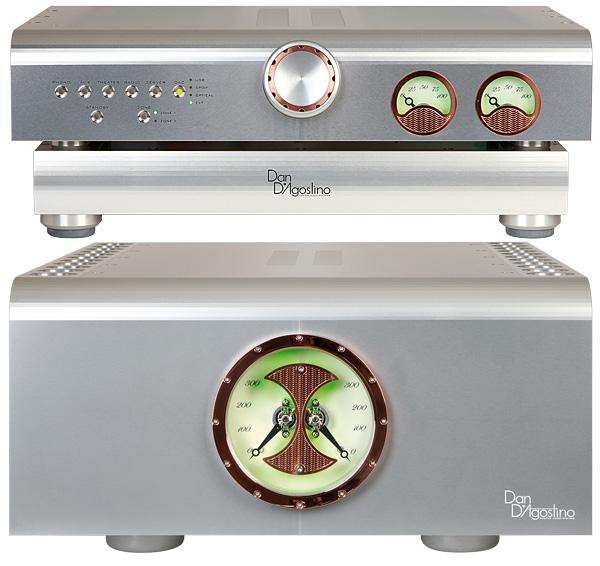
 Inspired by the ‘Momentum’ circuit and industrial design that put D’Agostino Master Audio Systems on the map, its Progression series could make the biggest impact yet
Inspired by the ‘Momentum’ circuit and industrial design that put D’Agostino Master Audio Systems on the map, its Progression series could make the biggest impact yet The Progression Stereo amplifier is built around a dual-wound 1400VA toroidal transformer coupled to 400,000µF of power supply storage capacitance that feeds no fewer than 48 power transistors – 24 per channel. On paper this is said to generate 300W/8ohm, doubling into 4ohm [see PM's Lab Report]. And it’s yours for roughly half the price of a pair of the company’s Progression Monoblocks [HFN Jun ’17].
Unsurprisingly, such monumental output power generates a good deal of heat that requires dissipation. As in the Momentum models, CEO Dan D’Agostino’s solution is a series of venturi-style circular ‘chimneys’ found either side of the amp. These are milled from a single 22kg aluminium slab, the material being more affordable than the rose copper used for the Momentum series, so helping to keep down costs.
Going Green
The Swiss watch-inspired green illuminated power meter that now adorns all the company’s preamps and amplifiers is retained, serving not only to differentiate the components from the competition – as the Krell blue LEDs once did for Dan’s first company – but to echo the brand’s green credentials. He believes that ‘the audio industry should do its part to conserve energy and help preserve our environment’. Remember those energy-hungry, fan-cooled Krell Class A amplifiers of yesteryear? Today’s Progression amplifiers are said to consume less than one watt of power at idle, though PM’s lab tests indicated otherwise of course!
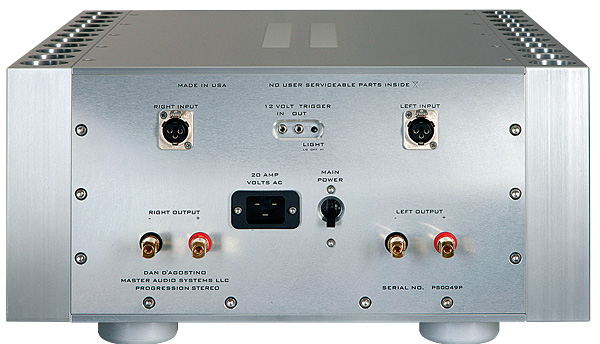
Dan has remained faithful to the fully balanced operation that was core to his Krell amplifier designs, aided in this new era by a ‘Super Rail’ that he likens to a turbo in a car engine, ‘boosting’ the output of the Progression Stereo by utilising higher voltage in the prior gain stages.
From a distance you cannot tell the Progression Mono and Stereo power amplifiers apart. They are equally imposing with the same 457x190x508mm (whd) dimensions and, at 57kg, they are equally back-breaking.
Only their power outputs differ, the Mono said to offer 500W/8ohm courtesy of the ‘two’ internal amplifiers operating as one bridged monoblock. Of course, the Progression Stereo power meter sports two swing arm needles in order to cover the output of both channels. And, of course, there are two balanced XLR inputs and two sets of gold-plated 4mm speaker binding posts.
Nothing else separates them at birth. They share the same clean fascia, dominated by that copper-green meter and have a power button hidden at the front underside edge. On the rear panel of both amps can be found a 12V on/off trigger connection, a toggle to set the meter brightness, a main breaker switch and the AC power connector.
I find the Progression amplifiers more appealing visually – and acoustically – than the Momentum models, and might be the only one who dares say it (though I have not listened to the Momentum M400 monoblock yet, reviewed in HFN Oct ’16). Which either makes this Progression Stereo a high-end ‘bargain’, or I risk making a fool of myself. To my mind they are just the right size and look even more purposeful – or should that be macho?
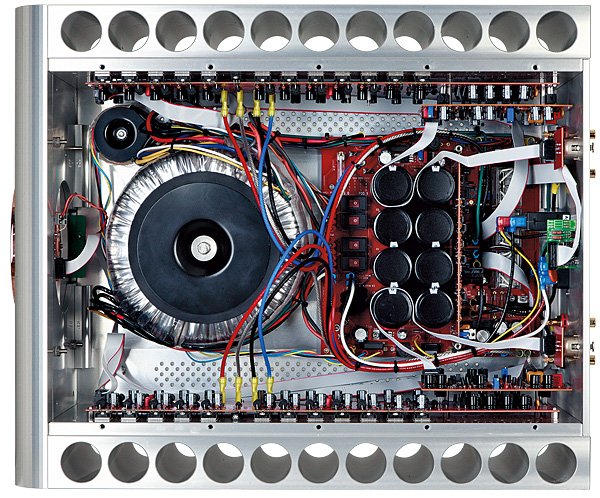
While we are on the subject of styling, the Momentum Preamp’s ‘watch’ necessarily protrudes because it includes a peripheral ring that spins into action [HFN Nov ’13]. But to some eyes this might not integrate so well with the amp’s overall cosmetics – looking like an add-on – while those rose copper heatsinks might also strike as a tad too feminine for our typically testosterone-driven audiophile tastes.
The Great Debate
The Progression Preamp was a tougher assignment for designer Dan. It’s not easy to challenge the Momentum Preamp – a work of art that’s hard to beat at any price. Personally, I love the design so much I could settle for the identical-looking Integrated [HFN Dec ’14] and forget all about the Momentum/Progression debate. Or else, go for the Momentum Preamp/Progression Stereo as an alternative to the Progression Preamp/Mono power amps. The price for both combinations is very similar, at around £72k.
For 50% of the price of the Momentum Preamp, the Progression Preamp yields 90% of the performance and far more than a mere sniff of the former’s beauty. What’s more, the Progression Preamp is the first of the company’s offerings to feature an optional DAC module that will set you back another £5000. The preamp also includes a Bluetooth remote handset that does not require line-of-sight to operate.
The Progression Preamp also features two multi-function meters (one per channel) that indicate signal level by default and gain and balance settings by selection. They also indicate inverted polarity, turning from green to red when you press the Polarity button on the remote; Mute, by alternating between green and white; or ‘Dark Mode’ by blanking out after 15 seconds.
The centrally placed volume knob, much more discreet than the Momentum’s, controls a precision-stepped attenuator that emits small clicks as you change the settings. A gain adjustment of +9dB or +15dB is also available, the latter to be used with low-gain power amplifiers. To the left of the front panel you can find the Standby, Zone, Analogue and Digital Source buttons. The latter’s LED indicators will only light if the DAC module is installed.
The slim chassis of the Progression Preamp is at least partially achieved by separating out its power supply into a convenient ‘base’, the two located via four spiked feet and connected via a supplied umbilical cable. The rear panel is otherwise rather busy with single-ended RCA inputs for Phono and Aux, and balanced XLRs labelled Theatre (bypass), Radio, Server and DAC. Two balanced XLR outputs are offered as ‘Zone 1 and 2’ while a plate covers the bay where the optional USB and S/PDIF DAC module may be installed.
![]() Magical Realism
Magical Realism
The Progression Preamp/Stereo joined a pair of Wilson Audio Alexia Series 2 loudspeakers [HFN Mar ’18] for the listening, with a dCS Vivaldi One media player [HFN Feb ’18] and Rossini DAC as digital sources. Transparent Opus cabling was used throughout while a Momentum Preamp and Progression monoblocks were on hand as a memory ‘refresher’.
I began with the Vivaldi One driving the Progression Stereo directly, only to be presented with a flat and rather pedestrian sound. It was only when I installed the Progression Preamp that the magic was revealed. Now the sound was infused with a tube-like bass bloom without any loss of lucidity, the pairing revealing the purpose, drama and sheer vitality of the music. In short, I was flabbergasted.
It was like using the luminosity slider in a photo-editing software package to banish noise that lurks in the shadows of a digital image. Less noise means greater dynamics not to mention a more convincing see-through presentation, the sounds emerging clearly against a pitch-black canvas.
The Progression Stereo drove the Alexia Series 2 effortlessly, and I was greeted with the same tonality, harmonic richness and differentiation of timbres as when I heard the speakers hooked up to the Progression monoblocks. The family resemblance is not just cosmetic. Both amps share the same ‘voicing’ and there’s no apparent lack of power or curtailing of dynamics. The Monos surf the soundwaves on a pair of skis, while the Stereo uses a snowboard, but they are both very ‘fast’.
Emotional Feast
To feel the pulse of the system I played the tracks I had used to test both the Progression Monos and Alexia S2 in these pages, and only then introduced new music, starting with London Grammar’s electronic pop debut album If You Wait [UM 0602537613120].
Both the title song and the opening track ‘Hey Now’ are heavy on digital reverb, conveying a feeling of ethereal spaciousness with weeping electric guitars, languorous keyboards and vicious bass lines. Hannah Reid’s voice is both powerful and filled with emotional urgency. The Progression combo feasted on this atmospheric ride, taking advantage of the time cues laid bare by the Alexia Series 2 and delivering all the air that the music needed to breathe.
The Progression duo pulled the same neat trick with natural reverb. Kim André Arnesen’s Magnificat [2L-106-SABD] was recorded in Nidaros Cathedral, Norway, by Nidaros Girl’s Choir, with soprano Lise Granden Berg. The sound was captured in 3D by a vast omnidirectional tree-array of microphones hanging some three metres above and in front of the strings and choir. I used the DXD stereo master (352.8kHz/24-bit) download.
The Progression Preamp/Stereo managed to convey not only the supreme beauty of the girls’ voices echoing and decaying naturally in the gothic cathedral but also the soprano’s moving spirituality, shining through the Alexia S2 with such religious emotion it could convert the devil himself. I certainly became a believer – if only in the Progression Preamp/Stereo amps.
Dark Stars
Back to Earth – and sin – and next up was ‘You Want It Darker’ from Leonard Cohen’s poignant final album of the same name [Columbia 0889853650729]. The Progressions delivered all the contrast between Cohen’s half-spoken, whispered grumble and the humming male choir and backing female vocals, while the dark, subterranean beat drove the song with a funereal pace towards its inexorable end: ‘I’m ready, my Lord’.
But I was not ready yet. I just needed something more uplifting. My hand reached for Keb Mo’s Peace, Back By Popular Demand [Sony 0886977026027]. I had been lucky enough to hear Keb Mo live in a private concert in New York, back in 2002. The kick drum sounded just as tight, the bass as articulate and Mo’s low-key vocals as present as I can remember, making the Stephen Stills’ song ‘For What It’s Worth’ almost danceable with its soul-jazz and funky adornments.
‘Wake Up Everybody’, the track that follows, is a peaceful call to arms: ‘All we have to do is put our heads and hearts together’. And the Progressions did put everything together. Bass and kick drum were as much rhythmically intertwined as they were differentiated in timbre. Meanwhile, the backup vocals and funky horns drew a tapestry against which Mo’s voice and percussionist’s strikes stood out clearly amid the colourful embroideries of guitars and keyboards.
Hi-Fi News Verdict
While it’s true that I began with a bias for the Momentum Preamp/Progression Mono combination, the Progression Preamp/Stereo duo, offering half the power for half the money, also gave me ‘the whole of the moon’. If I had to choose, I wouldn’t hesitate a moment(um). While clearly still expensive for many, this combo represents a true bargain and in my book the performance is more than enough to warrant the price.
D'Agostino Progression Preamplifier/Stereo pre/power amplifier Lab Report
While our inside shot reveals clear differences in the design of this Progression Preamp versus the more sophisticated Momentum Preamp [HFN Nov ’13], there are still clear parallels in their engineering targets. For example, the Progression Preamp has the same extended response (within ±0.1dB out to 100kHz) and there’s also that broad subsonic bass boost amounting to +0.45dB/20Hz and +0.95dB/5Hz. Distortion remains impressively consistent with frequency but is even lower here from 0.00065-0.00085% (Momentum) to 0.0005-0.0007% (Progression) across 20Hz-20kHz (0dBV). Overall gain is about 1.7dB higher at +9.8dB and the overall A-wtd S/N ratio wider still at 99.5dB (vs. 96.0dB) re. 0dBV.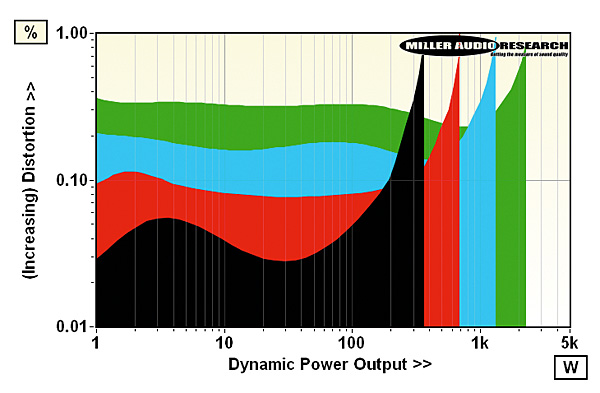
Dynamic power output versus distortion into 8ohm (black trace), 4ohm (red), 2ohm (blue) and 1ohm (green) speaker loads. Maximum current 47.9A
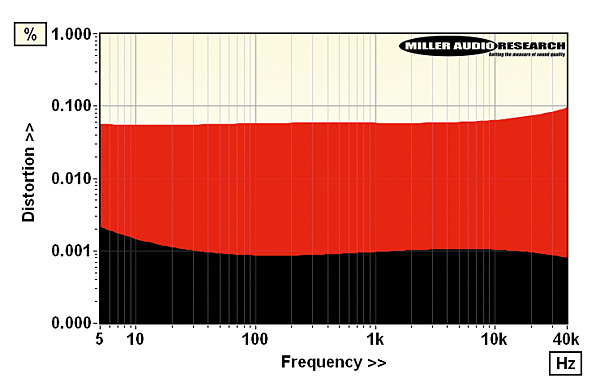 THD vs. extended freq for Progression Preamp (1V out, black trace) vs. Stereo (10W/8ohm, red)
THD vs. extended freq for Progression Preamp (1V out, black trace) vs. Stereo (10W/8ohm, red)
The partnering Progression Stereo is significantly beefier than the Momentum Stereo [HFN Aug ’12], behaving like a ‘half power’ version of the (bridged) Progression Mono [HFN Jun ’17]. Its 300W/600W 8/4ohm power rating works out as 2x325W and 2x575W in practice although that massive PSU will sustain peaks of 365W, 690W, 1.33kW and 2.29kW into 8, 4, 2 and 1ohm loads under dynamic conditions at <1% THD [see Graph 1]. Like other D’Agostino power amps, the Progression Stereo is neither super-quiet (the A-wtd S/N is just under 80dB re. 0dBW) nor very low in distortion. Of more importance, arguably, is the control exercised over this distortion – held between 0.02-0.07% from 1-100W through the midrange and a similarly consistent 0.04-0.07% over the full (20Hz-20kHz) audio band [see red trace, Graph 2]. Output impedance is held to 0.17ohm from 20Hz-10kHz and the response flat from near-DC to –0.12dB/20kHz and –1.6dB/100kHz. PM
Power output (<1% THD, 8/4ohm): 325W / 575W
Dynamic power (<1% THD, 8/4/2/1ohm): 365W / 690W / 1325W / 2290W
Output imp. (20Hz–20kHz, pre/power): 39ohm / 0.17–0.19ohm
Freq. resp. (20Hz–100kHz, pre/power): +0.45 to –0.13dB / +0.0 to –1.6dB
Input sensitivity (for 0dBV/0dBW): 322mV (pre) / 181mV (power)
A-wtd S/N ratio (re. 0dBV/0dBW): 99.5dB (pre) / 79.6dB (power)
Distortion (20Hz-20kHz, 1V/10W): 0.0005–0.0007%/0.040–0.071%
Power consump. (pre/idle/rated o/p): 33W / 113W/970W
No questions have been asked about this item.
Ask the seller a public question
You must log in to ask a question.
Return Policy
Return Window
Item can be returned within 7 days of receipt.
General Terms
Items must be returned in their original condition, with all included packing materials and no signs of use. Buyer assumes responsibility for all shipping return costs unless the item was not received as described.
Refunds
Buyer will receive a full refund in the original payment method less any shipping charges.
Listings Similar to Dan D'Agostino
10 Watchers


